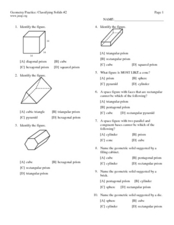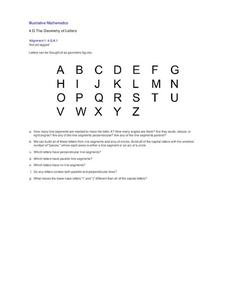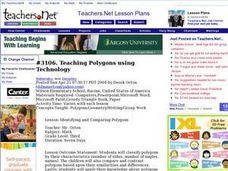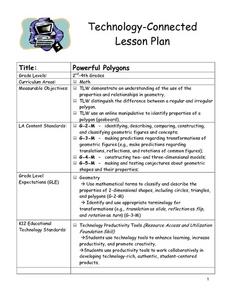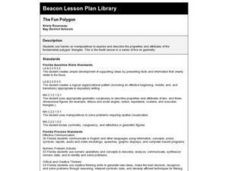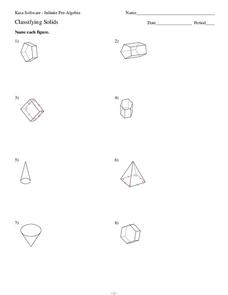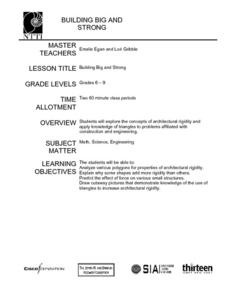Curated OER
Classifying Polygons
A straight edge, a right angle, a number of vertices; sounds like it's time to classify polygons. That's right you and your class will learn all about the properties of polygons and how to classify them with this easy to follow...
Curated OER
2-D polygons
A hands-on activity uses the Zome modeling system, and helps young geometers either learn or review their knowledge of polygons. Students build as many different 2-dimensional polygons as possible: triangle, square, rectangle, pentagon,...
Curated OER
Exploring and Classifying Polygons
Not particularly coloful, but definitely informative, here is an introductory presentation on polygons. The basic shapes are covered, from triangles to decagons. Special polygons like the trapezoid and the rhombus are also covered. Not...
Curated OER
Classifying Polygons
Seventh graders participate in a polygon hunt. In this polygon instructional activity, 7th graders examine how polygons are alike and different. Students create a Venn diagram and label the sorting circles. Students...
Curated OER
Exploring Polygons and The Greedy Triangle
Excellent lesson! Anne Linehane's geometry story, The Greedy Triangle, offers an opportunity to practice forming various types of polygons with your learners. Using elastic bands (or Chinese jump ropes),...
Curated OER
Classifying Polygons Worksheet
In this polygons learning exercise, students write the name of the polygon, and if it is not a polygon they write "none". Students complete 9 problems.
Curated OER
Geometry Practice: Classifying Solids #2
In this solids worksheet, students identify the characteristics of solids. They name solids and determine the number of faces. This three-page worksheet contains seventeen problems. Answers are listed on the last page.
Virginia Department of Education
Classifying Angles
Don't be obtuse, this geometry unit is the just the right resource for educating the acute young minds in your class. From classifying and measuring angles, to determining the congruence of shapes, this...
Curated OER
Classifying Polygons
Students study polygons. In this math lesson, students play a game in which they learn the classification system for polygons. Students identify the properties of quadrilaterals.
Curated OER
Polygon People
Students identify polygons. In this polygon people lesson, students draw required shapes and construct a polygon person. They identify each shape and its characteristics. The lesson may be extended by allowing students...
Utah Education Network (UEN)
Create, Classify, and Sort Quadrilaterals
Quadrilaterals can be quirky! Fourth graders use geoboards and bands to create four-sided figures. They analyze the attributes such as angle size and presence of parallel sides. As a result they learn to differentiate among...
CK-12 Foundation
Polygon Classification in the Coordinate Plane
Classify this resource into the "Use" pile. Scholars use an interactive coordinate plane to plot polygons given coordinates for the vertices. They use properties to classify each polygon and answer a few challenge questions regarding the...
CK-12 Foundation
Polygon Classification
Polly want a polygon? Young mathematicians sort shapes using an interactive. They classify the shapes as convex polygons, concave polygons, or not polygons.
Illustrative Mathematics
The Geometry of Letters
Use the alphabet as a tool for teaching your class about geometric figures. Break apart capital letters into line segments and arcs. Classify angles as right, acute, or obtuse. Identify parallel and perpendicular lines. An excellent...
Curated OER
Teaching Polygons using Technology
Third graders utilize different types of computer programs, such as Microsoft paint and Microsoft Word to study and create different types of polygons. They use PowerPoint to create a story about a shape and others that it meets during a...
Curated OER
Pondering Polygons
Seventh graders use block letter writing to help classify polygons. They use their own names which helps to keep them engaged during the lesson. Finally, 7th graders play a classification game naming different polygons.
Curated OER
Powerful Polygons
Students scan the classroom to find different common shapes. They listen as the teacher defines polygon and regular polygon. The teacher demonstrates regular polygons via the Internet and the "Math is Fun" web site. Students go outside...
Beacon Learning Center
The Fun Polygon
Junior geometers use hands-on manipulatives to explore and describe the properties and attributes of a fundamental polygon, the triangle. They learn different kinds of angles and their measurements. This well-written lesson plan provides...
Curated OER
Classifying Geometric Figures
Fourth graders recognize and classify geometric figures. In this geometry lesson, 4th graders read the books Shape Up and The Greedy Triangle and prepare a short report on the shapes mentioned in the text. Students compare the...
Curated OER
Properties and Attributes of Polygons
In this geometry activity, 10th graders determine if a polygon is convex or concave and apply the polygon Angle sum theorem and the polygon exterior angle sum theorem to determine the measures of interior and exterior angles of a...
Curated OER
Identify Polygons: Algebra/Geometry Institute
Eighth graders classify geometric figures. For this polygon lesson, 8th graders identify given geometric figures. They compare and contrast different polygons. Students name line segments, identify parallel lines, and...
Curated OER
Classifying Solids
In this geometry worksheet, learners classify polygons based on their sides and shape. There are 16 shapes to be identified with an answer key.
Curated OER
Building Big and Strong
Middle and high schoolers explore the concepts of architectural rigidity. They analyze a variety of polygons, and explain why some shapes add more strength to structures than others. The PBS video, "Building Big," is utilized in this plan.
Curated OER
Poly-Mania
This hands-on lesson takes young geometers on a tour of 2D polygons and 3D polyhedrons. After exploring different web resources and discussing geometric shapes, small groups construct models of polyhedrons using bendable straws. Note:...








